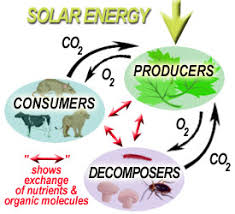ENERGY FLOW OF ECOSYSTEM
- The process of energy transformation in an ecosystem from one organism to the other organism is called energy cycle or flow of energy.
- The cycle of energy is based on the flow of energy through different trophic levels in an ecosystem.
- The sun is ultimate source of energy, and producers (Green plants) use solar radiation and make their food through photosynthesis. Thereafter this food is consumed by the different level of consumers and thus energy is passed on to different trophic levels.
- Primary producers i.e. green plants are being consumed by Herbivores (herbs eater) like rabbit, deer etc. Thereafter these herbivores are being eaten by carnivores (flesh eater). Omnivores (Man) are both herbs and flesh eater. Thus, the different plants and animal species are linked to one another through food chains.
- Decomposers like bacteria, fungi, molds, worms, and insects break down wastes and dead organisms, and return the nutrients to the soil, which is then taken up by the producers.

The flow of energy from one level to another level causes 90% loss of energy in the form of respiration and heat, thus only 10% energy is occurred. This energy flow is unidirectional. It means the energy trapped by the autotrophs, flow progressively through various trophic level but never revert back to its previous level. In this way, energy level for consumer at the each level is not the same.

Lindeman’s 10% law
According to this law only 10% of the energy entering in a particular trophic level is available for transfer to the next trophic level. All the energy transfers in a food chain follow the 10% law; it means the energy available at each successive level is 10% of the previous level.
Biogeochemical Cycles
It refers to the flow of chemical elements such as oxygen, carbon, nitrogen, phosphorous, and sulphur and compounds between organisms and the physical environment. Chemicals taken by organisms are passed through the food chain and eventually come back to the soil, air, and water through mechanisms viz. respiration, excretion, and decomposition. Such cyclic exchange of material between the living organisms and their nonliving environment is called Biogeochemical Cycle.
Some of the important biogeochemical cycle are-
- Carbon Cycle
- Nitrogen Cycle
- Oxygen Cycle
- Water Cycle
- Phosphorus Cycle
- Sulphur Cycle
Read more..
WHAT BIODIVERSITY IS-MEANING,TYPES&THREATS
IMPORTANCE OF BIODIVERSITY
BIODIVERSITY HOTSPOTS IN INDIA
TYPES OF THE ECOSYSTEM
WHAT IS WEEDS-CHARACTERISTIC, CLASSIFICATION & CONTROL
PRADHAN MANTRI FASAL BIMA YOJANA